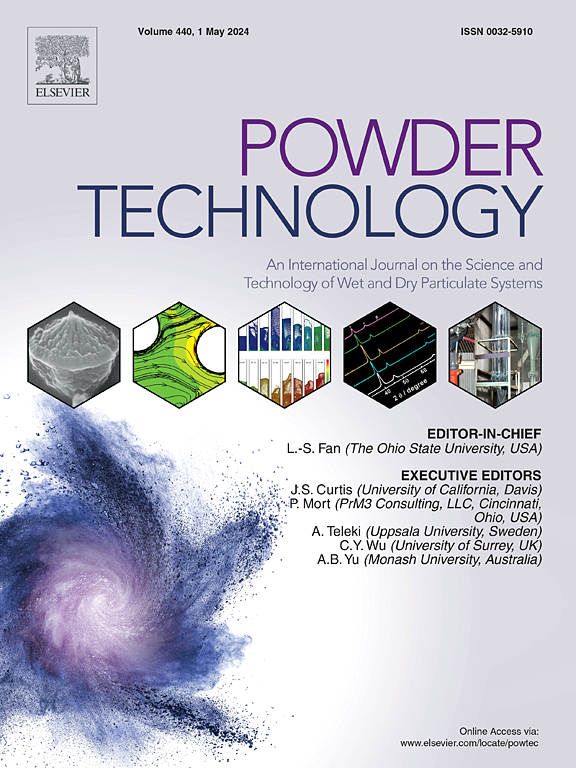不规则形状软松颗粒在 FT4 粉末流变仪中流动的离散元建模
IF 4.6
2区 工程技术
Q2 ENGINEERING, CHEMICAL
引用次数: 0
摘要
松树残渣是一种常用的生物质原料,它由不同的解剖学组分组成,每种组分都具有不同的颗粒特征。在这项工作中,开发了一种实验信息离散元素模型,用于研究松树残渣在 FT4 流变仪中的流动性。创建了具有不同颗粒属性的多球体颗粒,以模拟每种解剖馏分类型。对具有不同颗粒特征(如解剖组分类型、颗粒形状和大小)的试样进行了系统分析,以阐明颗粒属性与流动性之间的关系。结果表明,茎记录的轴向力和扭矩最大,相应地,流动能也最大,这归因于它们的高刚度和连锁效应。增加茎在混合物中的比例会增加流动能,而增加针则会降低流动能。本研究中获得的有关解剖馏分流动的知识对于高效、稳健地加工松木残渣非常重要。本文章由计算机程序翻译,如有差异,请以英文原文为准。

Discrete element modeling of irregular-shaped soft pine particle flow in an FT4 powder rheometer
Pine residues are a commonly used biomass feedstock that consists of different anatomical fractions, each with distinct particle characteristics. In this work, an experiment-informed discrete element model is developed to investigate the flowability of pine residues in an FT4 rheometer. Multi-sphere particles with distinct particle attributes are created to model each anatomical fraction type. A systematic analysis of specimens with varying particle characteristics (e.g., anatomical fraction type, particle shape, and size) is conducted to elucidate the relationship between particle attributes and flowability. The results show that stems recorded the highest axial force and torque and, correspondingly, the highest flow energy, which is attributed to their high stiffness and interlocking effect. Increasing their percentage in the mixture increases the flow energy while increasing needles tends to decrease flow energy. Knowledge gained in this study on the flow of anatomical fractions is important for the efficient and robust processing of pine residues.
求助全文
通过发布文献求助,成功后即可免费获取论文全文。
去求助
来源期刊

Powder Technology
工程技术-工程:化工
CiteScore
9.90
自引率
15.40%
发文量
1047
审稿时长
46 days
期刊介绍:
Powder Technology is an International Journal on the Science and Technology of Wet and Dry Particulate Systems. Powder Technology publishes papers on all aspects of the formation of particles and their characterisation and on the study of systems containing particulate solids. No limitation is imposed on the size of the particles, which may range from nanometre scale, as in pigments or aerosols, to that of mined or quarried materials. The following list of topics is not intended to be comprehensive, but rather to indicate typical subjects which fall within the scope of the journal's interests:
Formation and synthesis of particles by precipitation and other methods.
Modification of particles by agglomeration, coating, comminution and attrition.
Characterisation of the size, shape, surface area, pore structure and strength of particles and agglomerates (including the origins and effects of inter particle forces).
Packing, failure, flow and permeability of assemblies of particles.
Particle-particle interactions and suspension rheology.
Handling and processing operations such as slurry flow, fluidization, pneumatic conveying.
Interactions between particles and their environment, including delivery of particulate products to the body.
Applications of particle technology in production of pharmaceuticals, chemicals, foods, pigments, structural, and functional materials and in environmental and energy related matters.
For materials-oriented contributions we are looking for articles revealing the effect of particle/powder characteristics (size, morphology and composition, in that order) on material performance or functionality and, ideally, comparison to any industrial standard.
 求助内容:
求助内容: 应助结果提醒方式:
应助结果提醒方式:


